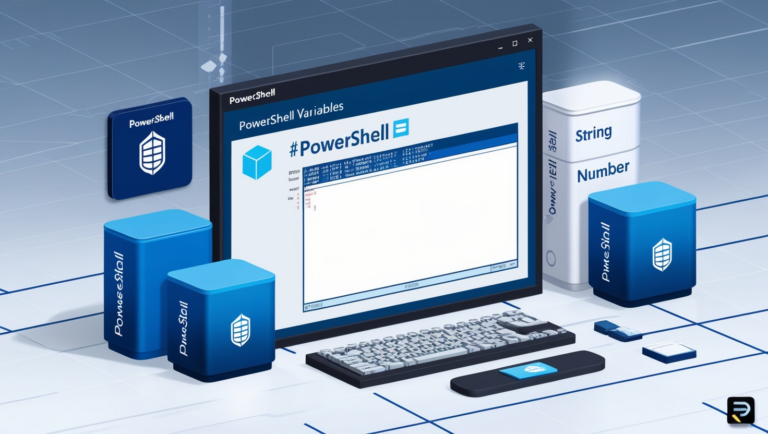Think of PowerShell variables as labeled storage containers – they hold whatever information you need to access later in your scripts. Just like how you might label boxes when moving house, variables help you organize and track data in your PowerShell scripts. In this tutorial, you will learn how to effectively work with these “storage containers” in PowerShell.
Prerequisites
To follow along with the examples in this tutorial, please be sure you have:
- Windows 10 or Windows Server 2016+ – All examples will use Windows 10 but concepts apply to any supported Windows version
- PowerShell 5.1 or PowerShell 7+ installed – This tutorial uses PowerShell 7 but the concepts work in Windows PowerShell too
- Basic familiarity with running PowerShell commands
Creating Your First Variable
Picture this: you’re writing a script to process files in a specific folder, and you’ll need to reference that folder path multiple times. Instead of typing out the full path each time (and risking typos!), you can store it in a variable.
Variables in PowerShell always start with a dollar sign ($) followed by the name. Here’s how you’d store that folder path:
$processingFolder = 'C:\ImportantFiles\ToProcess'Now anytime you need that path, just use $processingFolder. It’s like creating a shortcut to that longer piece of text.
The Perils of Undefined Variables
But what happens if you try to use a variable you haven’t created yet? By default, PowerShell is pretty forgiving – it’ll just return nothing. However, when writing scripts, that silent failure might mask problems. Let’s make PowerShell more strict with Set-StrictMode.
Set-StrictMode -Version Latest
$undefinedVariableNow PowerShell will let you know right away if you’re trying to use a variable that doesn’t exist – much better for catching mistakes early!
The PowerShell Way: Using Variable Cmdlets
While the basic $variable = value syntax works fine, PowerShell provides specialized cmdlets that give you more control and visibility. Think of these as the “professional-grade” tools for working with variables.
Set-Variable: The Power Tool for Variable Creation
Instead of the basic assignment, you can use Set-Variable:
Set-Variable -Name logFile -Value 'C:\Logs\ProcessingLog.txt'This approach gives you more options, like making variables read-only or hiding them from view.
Get-Variable: X-Ray Vision for Your Variables
Need to inspect your variables more closely? Get-Variable is your friend:
Get-Variable -Name logFile
You get back not just the value, but a proper PowerShell object with additional properties – super helpful when building robust scripts.
Real-World Example: Log File Processing
Let’s put this knowledge to work in a practical scenario. Say you’re writing a script to process log files:
# Store our config in variables
$logPath = 'C:\Logs'
$archivePath = 'C:\Logs\Archive'
$maxAgeDays = 30
# Now we can easily reference these throughout our script
Get-ChildItem -Path $logPath -Filter *.log |
Where-Object { $_.LastWriteTime -lt (Get-Date).AddDays(-$maxAgeDays) } |
Move-Item -Destination $archivePath
This is where variables really shine – the script is more readable and easier to modify. Need to change the max age? Just update one variable at the top.
Tips for Variable Success
Here are some battle-tested tips from the trenches:
- Use descriptive names –
$userListis better than$ul - Enable strict mode during development – catch problems early
- Use
Set-Variablewhen you need extra control - Remember, variables don’t survive between sessions
- Consider using a PowerShell profile for variables you always need
Next Steps
Now that you’ve got the basics down, you’re ready to explore more advanced variable concepts like:
- Arrays and hash tables for storing collections
- Custom objects for complex data
- Variable scope (think local vs. global)
- Automatic variables that PowerShell maintains
Conclusion
Variables are like the workbench of PowerShell scripting – they give you a place to store and organize all the pieces you’re working with. Whether you’re writing a quick one-liner or building complex automation, solid variable management will make your PowerShell journey much smoother.
Want to dive deeper? Check out PowerShell’s built-in help with Get-Help about_Variables. And remember, practice makes perfect – try using these concepts in your own scripts to really make them stick!




